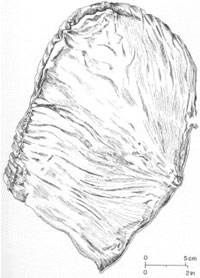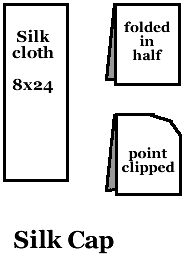Summary: In a search for proper headgear for a Viking lady of Jorvik, I found research done by Mistress Isabel Ulfsdottir and Mistress Thora Sharptooth on a silk cap found in the 16-22 Coppergate digs. After suffering a wind-chilled brain for part of the most recent Tourney of Ymir, I could see the wisdom in having some form of head covering in the Danelaw and Scandinavia. Inspired by this cap, I have made a headdress of my own from silk cloth with linen stitching and ties. I have decided to forego the embroidery around the edge of the cap given time constraints and that my skill in that department needs work.
Extant Examples: A silk cap with linen ties was discovered in the Coppergate digs. It is 8 inches deep and 24 inches long with finished edges. The fiber content of the cap itself was a silk tabby woven cloth. The ties at the chin are made of linen cloth sewn into stout ribbons. I could not find if the cap was sewn with linen or silk thread, but I am guessing linen. It has linen ties, not at the bottom corners, but close to the chin length along the elongated edge. With these dimensions the coif would have extended beyond the crown of the head to cover hair and keep a draft off of the neck. The ties appear to be linen ribbon on the silk coif. Other similar caps have been found. A woolen cap, discovered in Dublin, is of a similar construction. The Dublin cap is made of wool instead of silk and maintains a point at the back of the head. The point created in the Jorvik cap by folding the cloth in half was not snipped to shape to the head for the Dublin cap. This could be a more primitive cap in construction, or it could be regional stylistic differences. The ties on the Dublin cap are also attached at the corners of the cap where the front and bottom edges meet. This would eliminate the added warmth benefit to the back of the neck, but that benefit might not have been necessary in Ireland. Another cap was found in Lincoln but I do not have the information on that one.


Silk headdress found in Coppergate Viking digs, pictured in Walton on p.361.
Copyright © Walton
borrowed from Isabel Ulfsdottir's documentation
Beside my own creation of the cap
 Materials and Process: I started with a length of tabby woven silk noil cloth. I measured my own head and cut it to dimensions of 9 x 24 inches to fit. The piece was folded in half and and sewn with a running stitch in white linen thread along the back edge, making a curve for the top back to clip off the point. Only after the construction stitch was in place did I clip the actual point. Then each edge of the seam was folded flat and flat felled with a running stitch in the same linen thread used for sewing. Leaving the seam unfinished would not be in keeping with common practice and it would allow the edges to easily fray and thus not be as sturdy. The bottom edges were folded into a rolled hem, and the front edge was folded into a single hem as it is the selvage edge of the cloth. Lastly the ties were added to the front approximately an inch up from the bottom edge. This seems to reasonably fit my head but does leave less fabric continuing down the back of the neck on me.
Materials and Process: I started with a length of tabby woven silk noil cloth. I measured my own head and cut it to dimensions of 9 x 24 inches to fit. The piece was folded in half and and sewn with a running stitch in white linen thread along the back edge, making a curve for the top back to clip off the point. Only after the construction stitch was in place did I clip the actual point. Then each edge of the seam was folded flat and flat felled with a running stitch in the same linen thread used for sewing. Leaving the seam unfinished would not be in keeping with common practice and it would allow the edges to easily fray and thus not be as sturdy. The bottom edges were folded into a rolled hem, and the front edge was folded into a single hem as it is the selvage edge of the cloth. Lastly the ties were added to the front approximately an inch up from the bottom edge. This seems to reasonably fit my head but does leave less fabric continuing down the back of the neck on me.
This is admittedly not a very complex piece, but it was enjoyable to make. I do feel a cap or coif is a very necessary part of a proper viking woman's wardrobe. Headgear and footwear are the most often skipped steps when we get dressed in our garb. Hopefully by showing how easy it can be to make a documentable Viking headdress, more might attempt to finish their outfits.
Willadsen, Lisa. Embroidered Linen Headdress. 2000 http://willadsenfamily.org/sca/isabel_as/head-dress/NORSE_WOMANS_LINEN_HEAD-DRESS.pdf
Priest-Dorman, Carolyn. A Quick and Dirty Look at Viking Women's Garb in the Ninth and Tenth Centuries. 1999 http://www.cs.vassar.edu/~capriest/qdirtyvk.html
Priest-Dorman, Carolyn. Women's Garb in Northern Europe, 450-1000 C.E. Compleat Anachronist #59, SCA Inc. 1992.
Walton, Penelope, Textiles, Cordage and Raw Fibre from 16-22 Coppergate,Council for British Archaeology, London, England 1989.
-based on use in Lisa Willadsen's article